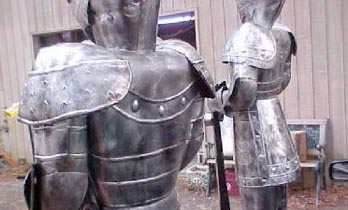Can nanotechnology help to protect soldiers in combat? Maybe some day. Scientists are working on something that they call liquid armor. In the old days, knights would walk around with really heavy clunky armor. That was OK, but it made it hard to do much of anything. Armor should be strong but light and flexible.
One possible way to make a better armor is to use something called a ‘shear thickening fluid’. What does that mean? It is a liquid that the harder you push on it the tougher it becomes. Liquid armor is made by suspending a lot of special nanoparticles into a liquid (as shown on the left). When you push on the nanoparticles-liquid mixture, the interactions between the particles seems to make the liquid thicker. So liquid armor is normally a liquid and the becomes instantly solid when you stab it with a knife or shoot it with a bullet.
Now, you can’t easily make liquid armor but you can make a shear thickening fluid at home. Try it at home. Take some water and mix in corn starch to make a thick paste. If you get it just right you will see that the faster you push your finger into it the thicker it gets. It won’t stop a bullet or a knife but you get the idea. The nanoparticles in corn starch are around fifty-thousand nanometers (about half the width of hair). Now scientists don’t use corn starch but different kinds of nanoparticles. Particles made from calcium carbonate (the same material that oyster shells are made of) or sometimes silica. These particles have a hard time slipping past each other and it gets worse if you make them move fast. To make liquid armor scientists take a solution of nanoparticles and use that to treat another strong material, Kevlar. The Kevlar helps keep the liquid in place.
Liquid armor is still in the testing phase but it shows promise and hopefully one day will protect soldiers and policemen from getting hurt.
Image Source: RDECOM Magazine

